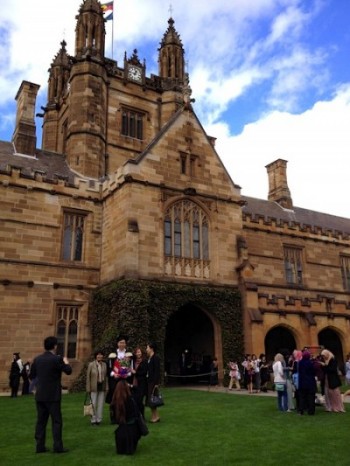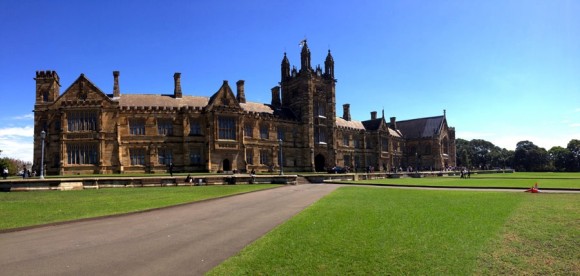
Attending elite University of Sydney will become more expensive under the Australian government’s proposed changes
When protestors took over ABC’s Q&A program in early May, chanting the rhythmic slogan “no cuts, no fees, no corporate universities”, Education Minister Christopher Pyne couldn’t stop himself from bursting into laughter.
It was as though Pyne thought the concerns of students were trivial and unimportant. Almost as if he thought higher education itself was a joke.
It comes as no surprise that Pyne can’t relate to current and future students; after all, he received his education for free.
Former prime minister Gough Whitlam fought to make higher education more accessible to working and middle class Australians. On 1 January 1974, he abolished university fees in Australia.
The future looked bright – we would all be more educated, have better jobs, contribute more tax and live in a robust economy.
However, the 1980s saw the rise of student fees and deregulation, along with the establishment of the Higher Education Contribution Scheme (HECS). Over the years, HECS contribution rates have slowly climbed with gradual deregulation.
The policies proposed by the 2014 budget bring the most radical changes to tertiary education in Australia since Whitlam.
From 1 January 2016, caps on commonwealth-supported places (CSP) will be removed, expanding access to higher education, a move in the right direction.
However, increasing access will also mean an increase in government spending. To counter these rising costs, the federal government intends to cut funding to tertiary education by 20 per cent.
It then becomes quite ironic that a policy introduced to increase access to education, at the same time decreases access by placing the burden of funding on students.
Greens spokesperson for higher education, Senator Lee Rhiannon, said the budget changes were a huge problem, especially for disadvantaged people.
“The impact of this budget is that it will increasingly push the cost of higher education onto students,” she said. “I believe that many people will be turned off considering going for a university education and even TAFE.”
 While Pyne has said, on numerous occasions, that students need to start contributing to the cost of their own education, NTEU President Jeannie Rea argues passionately that students do contribute “because most people with a university education do get better paying jobs and will pay more tax and that is how things work”.
While Pyne has said, on numerous occasions, that students need to start contributing to the cost of their own education, NTEU President Jeannie Rea argues passionately that students do contribute “because most people with a university education do get better paying jobs and will pay more tax and that is how things work”.
The changes don’t stop there.
In efforts to increase competition, higher education will also be completely deregulated, allowing tertiary institutions to set their own tuition fees.
Pyne told ABC’s Lateline’s Emma Alberici of his concern that “Asian universities [were] becoming extremely competitive”.
“We need to give our best universities the chance to compete against them and they need more revenue to be able to invest in research and quality teaching,” he said.
Rhiannon disagrees with Pyne, arguing that deregulation will instead lead to a great divide in the quality of tertiary institutions.
She sees the Group of 8 universities in an advantageous position because they are in high demand, enabling them to charge much higher fees.
Rea, agrees with Rhiannon on this, saying: “Universities that are less-well resourced, universities that are in the outskirts of the city, in the country, are likely then to start competing to charge less.”
Unlike those competitive Asian universities, whose governments are investing heavily in education, our government seeks to cut back funding and place the burden on students. Yet our government still wonders why the Asian universities are excelling at a much faster rate.
To add to this, from June 2016, HECS loans will no longer be indexed to the consumer price index, but to the 10-year bond rate capped at 6 per cent.
Debt would not only be added to by higher fees but also by the interest rate on payments. For Rhiannon, the issue is one of cost: “The lower the income that you receive on graduating, the more money you will pay back in interest because they have a compound interest system.”
The proposed changes have got many concerned. Under the current government, the days of free tertiary education are further from our reach than ever.
In the Lateline interview, Pyne responded to the idea of free education as though it were impossible.
“I guess in a Nirvana paradise kind of world, no students would have to pay for their university degrees; there’d be free housing for everyone; free health for everyone; free schooling for everyone. But unfortunately there isn’t that paradise on Earth anywhere,” he said.
But it isn’t impossible. Austria, Denmark, Finland and Norway are examples of countries that provide free tertiary education. Educated taxpayers, who got their education for free, are putting money back into the economy through higher taxes from higher paying jobs.
Local student Maxwell Man is greatly concerned about the cuts to higher education, seeing investments into education as important for Australia’s future.
“We just have to look at Norway to see that sometimes the best way to approach an issue is to invest more in it. They’ve got a great education system over there.”
Like many students, he was frustrated with the government’s proposed changes: “Now it’s becoming one of the most expensive places to study and there is something wrong with that.”
I chose to study in Australia because my citizenship allowed me to benefit from lower domestic fees. After recently comparing the cost of my degree with a relative attending Cambridge University, I was shocked to learn that it would have been cheaper for me to study there, also as a domestic student. Not only would I have saved in fees, but also greatly in living expenses.
The fact is there are universities that rank higher and are cheaper than universities in Australia. The government needs to give our students an incentive to not just study, but also to do it here.
| Place | Domestic | International |
| Sydney | N/A | $29,530 |
| London* | Capped at $16,190 | $6,290-32,280 |
| Copenhagen* | Free | $9,130 |
| Paris* | $290-950 | $2,470 |
| Finland* | Free | $3,660-17,570 |
| Austria* | Free | $878-2,200 |
| Switzerland* | $1,090-4,390 | $1,090-4,390 |
| University | ||
| MIT (#1) | $46,410 | $46,410 |
| Harvard University (#2) | $45,410 | $45,410 |
| University of Cambridge* (#3) | Capped at $16,190 | $24,580 |
| University College London* (#4) | Capped at $16,190 | $26,530 |
| University of Oxford* (#6) | Capped at $16,190 | $24,930 |
| Yale University (#8) | $46,280 | $46,280 |
| National University Singapore (#24) | $6560-20,740 | $13,460-41,488 |
| University of Hong Kong* (#27) | $5,650 | $18,120 |
| Australian National University (#27) | $14,880-28,815 | 25,984-30,111 |
| Ecole Normale Superieure, Paris* (#28) | $1,350 max | $1,350 max |
| HK University of Science and Technology* (34) | $5,830 | $16,110 |
| University of Sydney (#38) | $6,044-10,085 | $30,500-40,000 |
Note: All figures are per annum and include high cost degrees like medicine and law. Numbers in brackets (#) indicate world ranking of the university based on QS Top Universities ranking. *Indicate places/universities cheaper than Australia.
Violet Chan, an international student at the University of Sydney, was attracted to study in Australia by the lifestyle. But she was shocked when she found out how much cheaper tuition fees were for her friend studying in the UK.
“I think maybe it is a good way to study there and I can save more money, and I think their cost for their daily spending is also cheaper than here,” she said.
With tertiary education being our fourth biggest export industry, it is concerning that the rising cost of tuition fees may force international students to study in more competitive and less expensive places.
“If I want to study a further major, I may choose to study in the UK or US,” said Chan.
It is as though the federal government placed tertiary education on a dartboard, put on a blindfold and threw arrows. Their arguments that the changes will increase access, competition and quality do not follow logic or reality. I can only hope with optimism that our Senators have enough courage and sense to block the proposed changes to tertiary education and instead create a brighter future for Australia.





